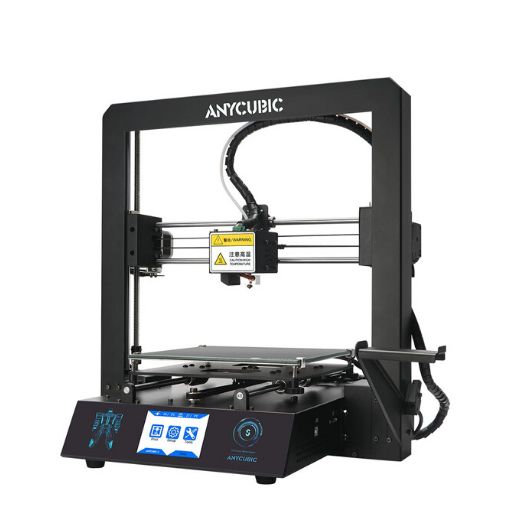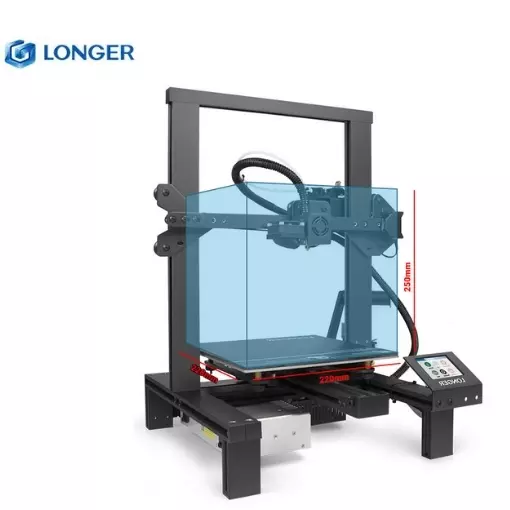Compare Ender 3 vs Mega S vs LK4
Comparison between the best 3D printers
Choose the best 3D printer at the best price. The cheapest 3D printers are here.
Buy a 3D printer here with 3D Fila.
 |
 |
 |
|
| Model | Ender 3[BUY Ender 3] |
Mega S |
LK4 |
| Printing Material | Filament | Filament | Filament |
| Estimated price | $210,00 | $149,00 | $200,00 |
| Fabricante | Creality 3D | Anycubic | Longer 3D |
| Release Year | 2018 | 2019 | 2019 |
| Print Volume [mm] | 220x220x250 | 210x210x205 | 220x220x250 |
| Printer Size [mm] | 440x440x465 | 405x410x452 | 402x425x505 |
| Weight [kg] | 6,62 | 14,5 | 7,8 |
| Power Loss Recovery | NO | YES | YES |
| Enclosed printer | NO | NO | NO |
| Bed Leveling | Manual | Manual | Manual com Assistência |
| Filament End Sensor | NO | YES | YES |
| Bed type | Heated | Heated | Heated |
| Power supply system | Bowden | Bowden | Bowden |
| Standard nozzle | 0,4 | 0,4 | 0,4 |
| Maximum Nozzle Temperature [°C] | 255 | 260 | 250 |
| Maximum Bed Temperature [°C] | 110 | 110 | 100 |
| Maximum printing speed [mm/s] | 180 | 100 | 120 |
| Filament holder | YES | YES | YES |
| Camera for supervision | NO | NO | NO |
| Recommended filaments | PLA, TPU, ABS, PETG | PLA, TPU, ABS, PETG | PLA, TPU, ABS, PETG |
| Recommended slicers | Cura, Simplify, Slic3r | Cura, Simplify, Slic3r | Cura, Simplify, Slic3r |
| Maximum Resolution [mm] | 0,1 | 0,1 | 0,1 |
| Processor | 8 bits | 8 bits | 8 bits |
| Display | Mono | Touchscreen TFT 2,8'' | Touchscreen TFT 2,8'' |
| Power Supply | 24V / 270W | 12V / 300W | 12V / 360W |
| Connectivity | SD / USB | SD / USB | SD / USB |
| Operating systems | Windows, Mac, Linux | Windows, Mac, Linux | Windows, Mac, Linux |
| Date of registration in the system | 2021-04-13 | 2021-04-15 | 2021-04-15 |
| Release date | 2018 | 2019 | 2019 |
| Extra features | The Ender 3 V1 is a DIY assembly 3D printer, a sales leader since 2017, standing out for its cost-benefit. With a wide printing capacity, it has a CNC machined structure for precision and stability. It offers high-precision prints with low noise, thanks to its innovative V-profile and pulleys. It has a self-adhesive magnetic platform for easy removal of models and excellent adhesion. The Ender 3 heats up quickly, reaching 100°C in 5 minutes, ideal for agile prints. It includes protection against power failures, allowing you to resume printing after interruptions, saving time and material. | The Anycubic Mega S offers a printing platform with excellent adhesion, easy removal after cooling. It has a filament sensor for a better experience with flexible materials and a multilingual and intuitive color touchscreen. Assembly is quick, requiring only 8 screws and 3 connections. It has a large build volume (210 x 210 x 205 mm), high positioning accuracy and supports a variety of materials, including TPU, PLA, ABS and wood. It stands out for its solid metal structure, superior stability, high-quality printing with layer resolution of up to 50 microns, Ultrabase for easy adhesion and removal of parts, resumption of printing after power outage, high-quality extruder for flexible filaments, suspended filament support and stable structure that reduces shaking, improving printing quality. | The Longer LK4 is a versatile 3D printer capable of working with a wide range of filaments, such as PLA, ABS, TPU, copper, wood and carbon fiber, thanks to its 0.4mm nozzle and heated bed up to 110°C. With a printing accuracy of between 0.05-0.4mm, it stands out for its solid construction with an aluminum frame, weighing around 7kg, and a robust 24V and 15A power supply. The kit includes an Allen key, a 7/10 key, a microSD card with USB adapter, a spatula, cable ties, a power cable, 5m of filament and a spare filament end sensor. Assembly is simplified, with around 90% of the equipment pre-assembled, and detailed instructions assist in the process. Special features include print recovery after power failure, a filament end sensor, a super-adhesive printing surface and an intuitive color touchscreen display. The design features smooth profiles for easy assembly, and the position of the filament holder optimizes the filament path to the extruder. The LK4 is a solid choice for 3D printing enthusiasts looking for quality and versatility. |
| Support for multiple colors and materials (AMS and CFS) | NO | NO | NO |
Notes * |
|||
| Cost-benefit | 6 / 10 | 7 / 10 | 7 / 10 |
| Hardware | 0.5 / 10 | 2 / 10 | 2 / 10 |
| Screen | . | . | . |
| Print volume | 3 / 10 | 3 / 10 | 3 / 10 |
| Performance | 1 / 10 | 1 / 10 | 1 / 10 |
| [BUY Ender 3] |
Conclusion |
| In concluding the comparison of the three 3D printers—Ender 3, Anycubic Mega S, and Longer LK4—it is evident that each model offers its unique advantages catering to different user preferences and budgets. The Ender 3, with its reliable performance and solid construction, makes a strong case due to its cost-effectiveness and community support. It has a robust design which has garnered widespread user acceptance, despite lacking advanced features like a power loss recovery system. Its manual leveling can be a downside for beginners but is manageable with experience. The Anycubic Mega S stands out for its user-friendly features including a touchscreen interface and a filament sensor, enhancing the overall printing experience. Its solid metal build ensures stability, and the high-quality Ultrabase bed provides excellent adhesion and ease of use. While its price point is slightly lower, the additional features may justify the cost for those seeking convenience and efficiency in their printing tasks. Lastly, the Longer LK4 presents a balanced option with versatile filament compatibility and straightforward assembly. It excels in power recovery functions and includes thoughtful extras like a filament end sensor and a user-friendly touchscreen. While it weighs slightly more, its sturdy aluminum frame provides durability, making it appealing for those who prioritize stability. In terms of affordability, the Anycubic Mega S offers the best cost-benefit ratio at a lower price, whereas the Ender 3 and Longer LK4 provide more functionalities at a mid-range price. Ultimately, the decision hinges on user needs: whether one values a more straightforward assembly experience, advanced features, or robust community support in their 3D printing journey. Each model caters well to specific requirements, ensuring that there is a suitable option for varied types of users in the 3D printing landscape. |

